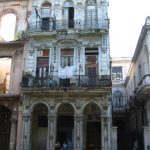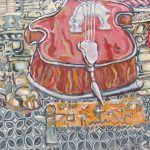- The Gift of Cuba
- Havana
- Pets
- Transportation
- Spanish Classes
- Tourists and the People They Attract
- Fidel, Che and Jose Marti
- Money
- Economics, Wealth and Poverty
- Food, Water and the Hotel
- Health and Education
- The Arts
- Looking Back
Economics, Wealth and Poverty

A couple of ancient women hung out near our hotel, and I felt so sorry for them, their stick figures clothed in threadbare dresses the result of their forced diet and restricted resources. On my first day in Cuba, a rail-thin woman held out her bony hand and asked me for a dollar. I have traveled extensively in developing countries and have dealt with beggars even at home. In India begging is a profession, but still I feel hard-hearted when I pass them by. I try to work at the causative level to deal with their problems when I can. We were told in our orientation to Cuba that the most vulnerable people now are the older people. The state homes for the elderly are rather grim places and some of them prefer to roam the streets, hoping for help. Even so, we were told by our hosts not to give in to pleas for money or risk encouraging even more pitiful beggars, which would hinder the fragile tourism, which brings in needed dollars. Heady stuff, but one to one, it was difficult to say no when I knew their deprivation was the partial result of my country’s unjust policies. I felt cold and conflicted when I told that woman I knew the government fed her, but she said, “Yes, I have food to eat. I won’t die, but I am hungry all the time.” I cringed, imagining myself in that situation. I smiled weakly and walked away gritting my teeth, my compassion overridden for the moment by the official policy.
The next day, as I neared the hotel, I saw one wraith-like elderly woman standing near a group of pudgy tourists with their bright holiday clothing and expensive cameras. They were too wrapped up in their new experiences to see her, standing there only a few feet from them, her thin dress flicked by the light breeze. She wasn’t begging, just watching them. She looked confused or stunned, one hand loosely held the other in front of her chest as if she needed that hand to be held and there was no one else to do it. Immediately, I projected my own mother in her situation and it stung me to the quick.
Later, I gave in to an old man, one of many older people who supplement their incomes by selling the weekly newspaper, Granma. They asked a US dollar for a copy, but the printed price was fifty cents. The first time, I pointed out the discrepancy, but the grizzled man replied, “Oh, yes, but I have to buy them at that price. And I have to support myself. I need to eat.” So I winked, having made my point, and paid the dollar.

I generally had less trouble paying more than the going price for something than simply giving out money, as long as the seller knew that I knew that was the case. Maybe I was saving face, or maybe I just softened to their pleas over time. Even though they could buy an espresso for a peso and it cost me a dollar, a bar of soap, other than the sliver they were given as a part of their monthly rations, would be the same price for both of us.
Around the plaza near our hotel, cigar women pose in the corner of a doorway waiting for tourists willing to pay for a picture. They are not as skinny as the others, though to call them plump would be an exaggeration. All the women wear older dresses, clean and white with some ruffles, and a Carmen Miranda-style hat, lots of color. Most have a cigar to complete the picture, which they will feign to smoke for the proper price. Apparently they can get up to $10 per from gringos, which pretty much messed up my offer of a bar of soap when I got the courage to try for a shot. I’ve seen the pictures of them in Havana books, so I didn’t worry that I didn’t have my own photo.
Sugar has dominated the Cuban economy since Christopher Columbus brought the first cuttings on his second visit to the New World. Spanish planters used the indigenous Taino population in the fields until they died from overwork and disease, and then they imported Africans. In the early 19th century, French planters fleeing the Haitian slave revolt brought new techniques and by the 1860s, tiny Cuba was supplying one third of the world’s sugar. Americans quickly moved into ownership, and at the end of the Wars of Independence from Spain in 1898, they were poised to take control of the land and the country from the retreating Spaniards. When Castro came to power and nationalized businesses, the wealthy Cubans left the country. Hawaii became the major supplier of the US sweet tooth while Cuba’s sugar continued to be its primary export to the USSR and China.

Most statements from our guide or lecturers about the current economy seem to stem from the beginning of the Special Period, which began when the Russians retreated in the early nineties. During the years when Cuba was supported by the Soviet Union, things were going fairly well. Cuba traded its sugar among the Communist Bloc for what it needed. The Soviet Union subsidized Cuba’s economy to have a toehold of influence close to the US. Some people even feel it was that support that bankrupted the Soviet Union.
When the Soviets left, the Cuban economy collapsed. It all happened very suddenly and Cuba was unprepared to sustain itself. Miami Cubans were thrilled at the distintegration of the Soviet Union and had their bags packed to return, but Cuba surprised them and survived. The first few years were the worst. Cuba had to adapt to having no market for its sugar and thus no way to trade for fuel and other essential goods. Fuel shortages meant food shortages since farmers had no way to get the food from the agricultural areas on the island to the markets in the cities, if indeed they had been able to raise crops at all. Prices were government controlled and the basic needs of the people are supposed to be met through their ration book. However, what used to suffice has been cut so that when I was there each person received six pounds of rice, three pounds of split peas and six eggs a month. I read in the weekly paper that farmer’s markets were opening up and the farmers were even demanding higher prices for their produce, so things were changing for the farmers, but only those with dollars will be able to buy what they had to sell.

Recent efforts to attract tourists and their hard money have helped to shore up the economy, but older Cubans understand what in influx of tourists and their money can mean. Earlier in the century, Cuba was a refuge for people who resented the restrictions of Prohibition, and in the 1940’s and 1950’s control of gambling, drugs and prostitution was in the hands of US crime bosses who operated with impunity in Havana.
The year before I visited was a very bad year for crops in Cuba and hurricanes had devastated much of the island. Archer-Daniels-Midland, a US agricultural corporation, managed to persuade Congress to allow them to ship grain and chicken into Cuba for humanitarian reasons. The reasons they gave are noble, but they are an aggressive corporation that has taken advantage of trade agreements to increase profits at the cost of further impoverishing poor countries. I doubt their reasons were as pure as they presented. Cubans are very aware of what could happen to them if the barriers to trade are eliminated and currently, all foreign business have to agree to a minor partnership with the Cuban government.
Throughout the Special Period, the first priority had been the people, their sustenance, their health and their education. Suddenly there was no lard for cooking and little meat. Basic foods were available but not in abundance. No one starved, but everyone was hungry. The doctor who spoke to us on the health system made light of how the austerity measures were a good thing. People lost weight. Their cars were useless and they had to walk or ride one of the thousands of bicycles sent by China to help in the crisis.
We were told to carry lots of one-dollar bills, and we found frequent occasions to tip a dollar, in the hotel or to musicians who played in the restaurants. I was usually in a philanthropic mood, and just tipped as an honorable way to sharing my privilege. Yet I felt conflicted when I stuffed my dollar into the gourd the musician held out for our contributions during dinner, when I would have preferred a quiet meal rather than the noisy music. Harsh, I know, but sometimes I really craved some peace and quiet. I was tempted to take my dollar and go down to the street and look for one of the frail women if was only a matter of sharing my largesse, but I never did.

Cubans do have noticable economic strata in spite of the rhetoric of equality, but the difference between the highest and lowest income level is nothing like the United States. Economic differences in Havana are there to see, especially in the clothing. If a Cuban can afford to shop in the dollar stores, stores that only take US Dollars, what is available is not very stylish. The most fortunate ones get clothes shipped to them from the US, stylish by US standards and with desirable brands. According to one source, the average salary is $9.30 a month. A Cuban family who receives $100 per month by relatives in the U.S. can do very well. In addition, people in contact with tourists, who are tipped in US $1 bills are able to raise their standard of living.
The economic pyramid with professionals traditionally on top has been inverted. My profesora at the school told us that the teachers were pressing for an increase in their relatively low government salaries. Taxi drivers often were well educated far beyond what a taxi driver needs to be, but they drove for the better money.
The well-kept mansions we passed in the Miramar area once belonged to the wealthiest Cubans who live in Miami. The houses are occupied by representatives of the corporations, usually European, that are willing to partner with the Cuban government. We were told that at the end of one street, was one of the houses Fidel Castro kept for himself.